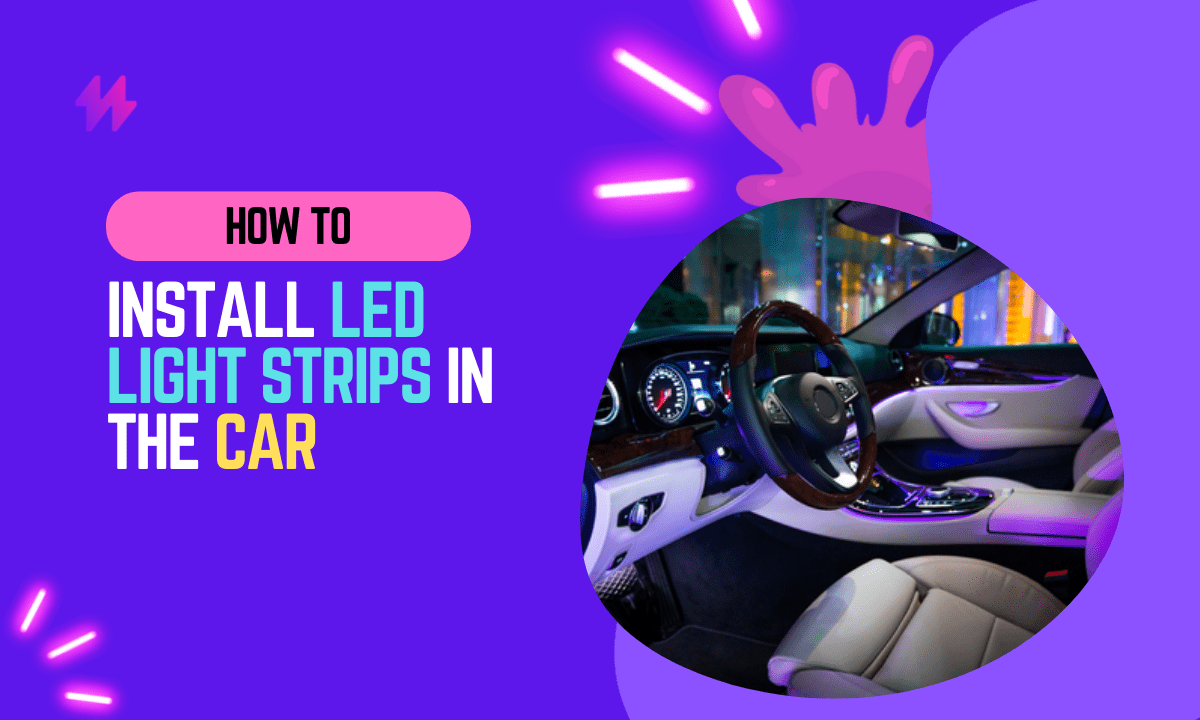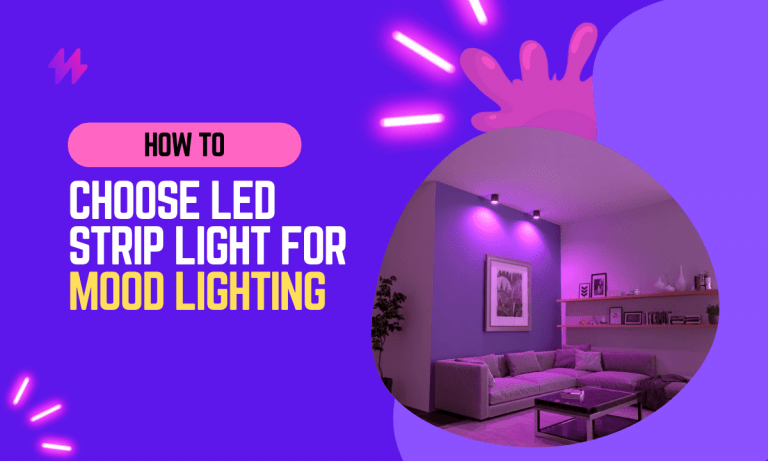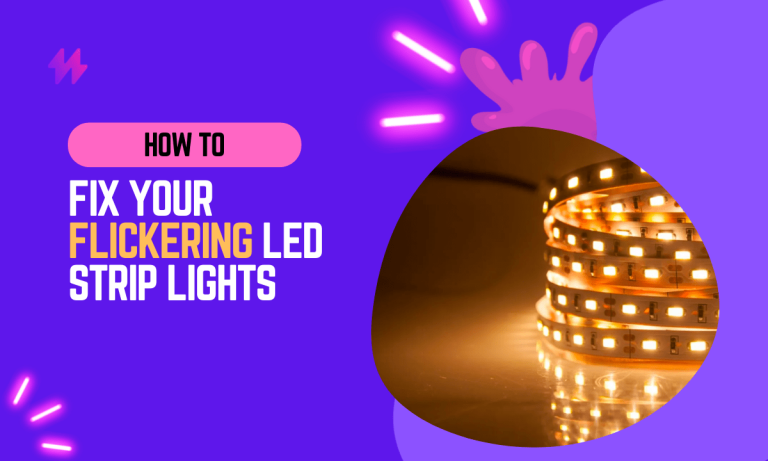How to Install LED Light Strip in Car – The Easy Way

Installing LED lights strip in your car is a great way to improve its appearance, safety, and performance. LEDs are bright, colorful, and efficient, making them the perfect choice for automotive lighting. In this article, we’ll show you how to install LED strip lights in your car using the best methods and products available.
To effectively enhance your vehicle’s ambiance, consider using an LED controller that allows for customizable brightness levels and light effects. Whether you opt for RGB LEDs or blue LEDs, these light strips work to create a vibrant atmosphere in your car interior, making every ride enjoyable.
Understanding LED Strip Lights: Why and How to Install LED Light Strip in Your Car – The Easy Way
LED (light emitting diode) lights are bright, energy-efficient, and long-lasting lighting solutions that have become increasingly popular in recent years. LED light strips are strips of small LED lights that can be used for a variety of purposes, including accent lighting, underglow lighting, and even brake light upgrades. Many car enthusiasts install LED light strips in their cars to improve the vehicle’s appearance and performance.
LED light strips are a great way to improve the appearance, safety, and performance of your car. They are available in a variety of colors, sizes, and styles, so you can find the perfect strip for your car. In addition to improving the look of your car, LED light strips can also provide additional safety features. For example, some strips are designed to be used as brake lights.
LED lighting has revolutionized how we enhance the aesthetic of our vehicles, offering a range of options for customization. When considering light strip installation, it’s essential to understand how to install LED light strip in a car – the easy way, ensuring a seamless integration with your car’s electrical system.
How to Install LED Light Strip in Your Car – The Easy Way to Choose and Transform
Not all LED light strips are created equal. When choosing a strip for your car, you’ll need to consider a few factors.
When selecting LED light strips for your vehicle, it’s crucial to evaluate factors such as brightness and color options to achieve the desired ambiance. The proper installation of your light strip set and understanding how to install LED light strip in car – the easy way will ensure you create a colorful car environment while preventing issues like uneven lighting.
- First, you’ll need to decide what purpose the strip will serve. Will it be used for accent lighting, underglow lighting, or brake light upgrades? Once you’ve decided on its purpose, you’ll need to choose the right size and style of the strip.
- Next, you’ll need to consider the type of vehicle you have and determine whether it’s compatible with LED lights. Not all vehicles can handle the extra load that LED lights put on the electrical system, so make sure to check before purchasing any strips.
- Finally, you’ll need to pick a color or colors for your LED strip. Most strips come in a variety of colors including red, blue, green, white, and amber. You can also find RGB (red-green-blue) strips that allow for infinite color combinations.
How to Install LED Light Strip in Car: The Easy Way to Install LED Strip
Once you’ve chosen the right LED light strip for your car and determined that it’s compatible with your vehicle, it’s time to start installing it! Here are step-by-step instructions on how to do it:
1) Remove the old lights if any and find a place you plan to install the LED strip lights.
2) Cut the LED strip to length using scissors or a knife – make sure not to cut off any of the wires sticking out of the end of the strip.
3) Strip about 1/2 inch of insulation from each wire using wire strippers or a utility knife.
4) Twist each wire around a connector (or use pliers) and crimp them together using a crimping tool.
5) If needed, attach the provided adhesive backing to the LED strip.
6) Peel off the adhesive backing and stick the LED strip in place.
7) Reconnect the electrical system and test the lights.
8) If everything is working properly, enjoy your new LED light strip!
Once you’ve completed the installation of your LED light strip, you may want to consider adding an LED driver to effectively manage your lighting system. This will ensure that your light-emitting diodes (LEDs) operate smoothly, providing optimal brightness and a soft light glow that enhances your custom car interior.
Tips and Tricks: How to Install LED Light Strip in Car – The Easy Way
Here are a few tips and tricks to help you get the most out of your LED light strip installation:
When choosing LED light strips for any modern vehicles, it’s helpful to have a great-looking LED setup that provides the right ambiance. Make sure to familiarize yourself with how the light strip connects to your car’s electrical system, especially with components like the LED power wire and ignition switch for optimal functionality.
- Use high-quality materials: When it comes to electrical work, it’s important to use high-quality materials. That means using good-quality LED light strips, wire strippers, connectors, and crimping tools.
- Follow the instructions carefully: Be sure to read and follow the instructions that come with your LED light strip carefully. This will help you avoid any mistakes during the installation process.
- Hide the wires: One of the most important things to do when installing LED light strips is to hide the wires. Not only does this give your car a cleaner look, but it also prevents any potential damage to the wires. You can use zip ties or adhesive tape to secure the wires in place.
- Test the lights before you install them: Once you’ve cut and connected the wires, it’s a good idea to test the lights before permanently installing them. That way, you can be sure they’re working properly before you put everything in place.
FAQs: Installing LED Light Strips in Your Car
Q: Do I need to use a special type of wire when installing LED light strips in my car?
A: No, you can use any wire that is able to handle the current draw of the LED strip. However, we recommend using a stranded copper wire for the best results.
Q: How do I know if my car is compatible with LED lights?
A: Not all cars are compatible with LED lights. To be sure, consult your vehicle’s owner’s manual or ask a professional mechanic.
Q: Can I install LED light strips myself?
A: Yes, you can install LED light strips yourself as long as you have the proper tools and know-how. However, we recommend that you consult a professional if you’re unsure about anything.
Q: What are some benefits of installing LED light strips in my car?
A: Some benefits of installing LED light strips in your car include improved visibility, safety, and style. LED light strips can also help you save money on your car’s electrical system by drawing less power than traditional bulbs.
If you’re considering upgrading your vehicle’s lighting, it’s important to choose the right materials for a successful installation. Ensuring that your car’s power supply can handle the new light sets will lead to great-looking LEDs that enhance your car stereo and provide a soft glow throughout the cabin.
Final Thoughts on Installing LED Light Strips in Your Car
In conclusion, installing LED light strips in a car can dramatically enhance the vehicle’s interior aesthetics, providing a modern look and custom ambiance that reflects the owner’s personal style. The process is straightforward and can be accomplished with minimal tools and technical skill. The key to a successful installation is proper planning and preparation. Before beginning, it’s important to determine the placement of the strips for optimal effect and accessibility, whether under the dash, along the door panels, or in the footwells. Ensuring that the surface is clean and dry before attaching the light strips is crucial for the adhesive to bond effectively. This step prevents the lights from loosening over time, which is especially important in a moving vehicle where vibrations and temperature fluctuations are common.
Moreover, wiring the LED strips correctly is vital to maintain both safety and functionality. Connecting the lights to a stable power source in the car, such as the fuse box or directly to the battery with proper fuses, ensures they operate reliably without draining the vehicle’s battery or interfering with its electrical system. Utilizing connectors and ensuring all wires are secured and insulated can help avoid electrical shorts and potential damage. For those less experienced with electrical installations, consulting with or hiring a professional may be advisable to ensure the lighting is installed correctly and safely. By following these guidelines, car owners can achieve a dynamic lighting setup that not only enhances the driving experience but also adds a personalized touch to their vehicle, making every ride more enjoyable and stylish.
How To Install LED Light Strip In Car – The Easy Way | Preparing for Installation
Preparing for installation requires careful selection of materials and tools to ensure a seamless process. Understanding How to Install LED Light Strip in Car – The Easy Way starts with choosing the right LED bulbs designed for car lighting. These LEDs work effectively for backlighting and can replace regular light bulbs in various parts of the vehicle, including underbody car lights and the rear bumper. A light strip controller is essential for managing color and effects while using electrical tape to secure the strip to under-dash plastic panels. Testing the setup with a test light ensures proper connection to the cigarette lighter, allowing for a separate on/off signal. Ensuring low/medium car voltage is vital to avoid damaging the LEDs and to maintain functionality, especially when incorporating resistors for compatibility with incandescent signal lines. Selecting the appropriate setup can enhance visibility and provide extra lighting in both the front and rear of the sedan.
How to Install LED Light Strip in Car – The Easy Way | Selecting the Right LED Light Strip
Selecting the right LED light strip is crucial for achieving the desired ambiance in your vehicle. A variety of options exist, including flexible strip lighting that can contour to various surfaces. Look for strips that offer visible light and a range of colors to enhance your car’s interior. It’s important to consider compatibility with your custom car amp, ensuring that your setup can handle the power requirements without overloading. Understanding how to install LED light strip in car – the easy way begins with proper selection.
Take note of the power source needed for your LED lights. Many strips connect directly to the fuse power of your vehicle, which allows for easy installation and reliable operation. Ensure that the wattage of the strip aligns with your car’s electrical system to prevent any issues. Familiarity with how to install LED light strip in car – the easy way will help you choose the right components, ensuring a smooth and efficient setup process.
Tools and Materials Needed
Gathering the right tools and materials is essential for a successful installation. To embark on your journey of how to install LED light strip in car – the easy way, consider purchasing an LED light strip kit, which typically includes the lights, adhesive backing, and connectors. A pair of scissors may be necessary for cutting the light strip to fit your space, while a lighter or heat gun can help you secure connections.
Beyond the LED light strip, ensure you have tools such as a screwdriver, wire stripper, and electrical tape on hand. A power source, like an auxiliary port adapter or a battery pack, will be crucial for connecting your lights. Knowing how to install LED light strip in car – the easy way can be greatly aided by having zip ties or clips for neat cable management. Proper preparation with the right tools makes the installation process smoother and more efficient.
StepbyStep Installation Guide
Installing LED light strips in your car can transform its interior ambiance, making it feel more modern and inviting. Learning how to install LED light strips in car – the easy way involves a systematic approach that ensures a seamless and effective installation. First, carefully choose the appropriate mounting locations that maximize visibility and effect without hindering driving. Following this, securing the strips requires precision to ensure they adhere well and look aesthetically pleasing. By connecting the strips to a power source, you ensure they light up as intended. A thoughtful installation process will not only enhance your driving experience but also add a personal touch to your vehicle.
Mounting the LED Light Strip
To properly mount the LED light strip in your vehicle, selecting the ideal location is crucial. A common spot is under the dashboard, as it provides a subtle glow while being out of sight. Ensure that the surface is clean and dry for optimal adhesion. Following the tips in “How to Install LED Light Strip in Car – The Easy Way,” it’s helpful to perform a dry run by placing the strip in its intended position without removing the adhesive backing.
Once you are satisfied with the placement, carefully peel off the adhesive and press the strip firmly into place. For those looking to add extra security, consider using mounting clips or brackets, which can offer additional support without interfering with the strip’s appearance. This method aligns perfectly with the principles outlined in “How to Install LED Light Strip in Car – The Easy Way,” ensuring a neat and professional finish.
Connecting to Power Source
Properly connecting the LED light strip to the car’s power source is essential for functionality. Understanding how to install LED light strip in car – the easy way involves choosing a power source that matches the voltage specifications of your LED strip. Most strips operate on 12V, making the car’s battery an ideal option. Identify the best location for the power connection, typically near the fuse box or dashboard area.
To make a secure connection, consider using a fuse tap or a switch. This approach ensures that the LED lights can be turned on and off without directly connecting to the battery. Follow the guidelines on how to install LED light strip in car – the easy way to avoid any short circuits. Use appropriate connectors and soldering techniques if needed, ensuring that all connections are firmly attached for optimal performance.
Customization Options
Customizing your LED light strip can significantly enhance the atmosphere inside your car, making it a unique reflection of your style. Knowing how to install LED light strip in car – the easy way allows you to explore various options for colors and effects. Choose from vibrant solid colors or dynamic multi-color modes to set the mood according to your preferences. Many LED strips also offer different lighting effects, such as fading or flashing, that can be synchronized with music. For added convenience, consider setting up remote controls, enabling you to effortlessly adjust settings on the go. This level of customization transforms your driving experience and makes it truly personal.
Choosing Colors and Effects
Selecting the right colors and effects can greatly enhance the ambiance of your car’s interior. LED light strips offer a variety of options, enabling you to customize the lighting according to your preferences. Think about the mood you want to set, whether it’s a calming blue for relaxation or a vibrant red for a lively atmosphere. Understanding how to install LED light strip in car – the easy way includes exploring these color choices to find what suits your style best.
Many LED light strips come with built-in functions that allow you to cycle through colors or create dynamic lighting effects. This feature adds an exciting element to your car, making the driving experience more enjoyable. Experimenting with different effects such as fading, strobing, or solid colors can provide not just visual appeal but also a chance to personalize your space. Remember, knowing how to install LED light strip in car – the easy way means making informed decisions about colors and effects that resonate with your personality.
Setting Up Remote Controls
Remote controls enhance the versatility of LED light strips in your car. To set them up, first ensure that the strip is connected to a compatible receiver. This receiver usually comes with the LED light strip kit. Following the instructions for your specific model is essential for seamless integration. Understanding how to install LED light strip in cars – the easy way – includes knowing how to pair the remote with the receiver to allow for the full range of color options and effects.
Once the remote control is paired, familiarize yourself with the different functions available. Most remotes feature buttons for adjusting brightness, cycling through colors, or selecting dynamic effects. Experimenting with these settings can help you determine which combinations suit your mood or driving environment best. Mastering how to install LED light strip in cars – the easy way, means enjoying a personalized lighting experience that enhances the ambiance of your vehicle.
Safety Considerations
Ensuring proper electrical connections is crucial for anyone learning how to install LED light strip in car – the easy way. Loose or faulty connections can lead to flickering lights or even potential electrical hazards. It’s important to securely connect wires and use appropriate connectors to maintain a stable power supply. Preventing overheating and damage is equally vital; installing the strips in well-ventilated areas can help avoid heat accumulation. Keeping these safety measures in mind will ensure a successful and safe installation process while transforming your car’s interior.
Ensuring Proper Electrical Connections
Proper electrical connections are crucial for the successful installation of LED light strips in your car. Understanding how to install LED light strip in car – the easy way includes knowing how to connect the wires securely. Loose connections can lead to flickering lights or total failure of your LED strips. Always ensure that the connectors are tightly fitted and that there are no exposed wires that could cause a short circuit.
Wiring harnesses are often used for these connections, so selecting the appropriate size and type is important. Using the correct gauge wire can help avoid overheating and power loss. Following the guidelines for how to install LED light strip in car – the easy way will not only improve performance but also enhance safety while driving. Properly securing all connections with electrical tape or heat shrink can provide additional protection against moisture and vibrations inside the vehicle.
Preventing Overheating and Damage
Overheating can lead to serious issues when installing LED light strips in your vehicle. Understanding how to install LED light strip in car – the easy way involves making sure that each strip is rated for the power supply being used. Avoid overloading circuits by matching the power requirements of the LED strips with the car’s electrical system. Check the manufacturer’s specifications and ensure that the wiring is sufficient to handle the current without causing excessive heat buildup.
Another key factor is ensuring proper ventilation around the installed LED light strips. Installing them in areas where air circulation is limited can cause the strips to overheat. Determine how to install LED light strip in car – the easy way by choosing locations that allow for airflow and will not trap heat. Regularly inspecting the connections and the condition of the strips will help you catch any early signs of wear or overheating, ensuring a longer lifespan for your installation.






